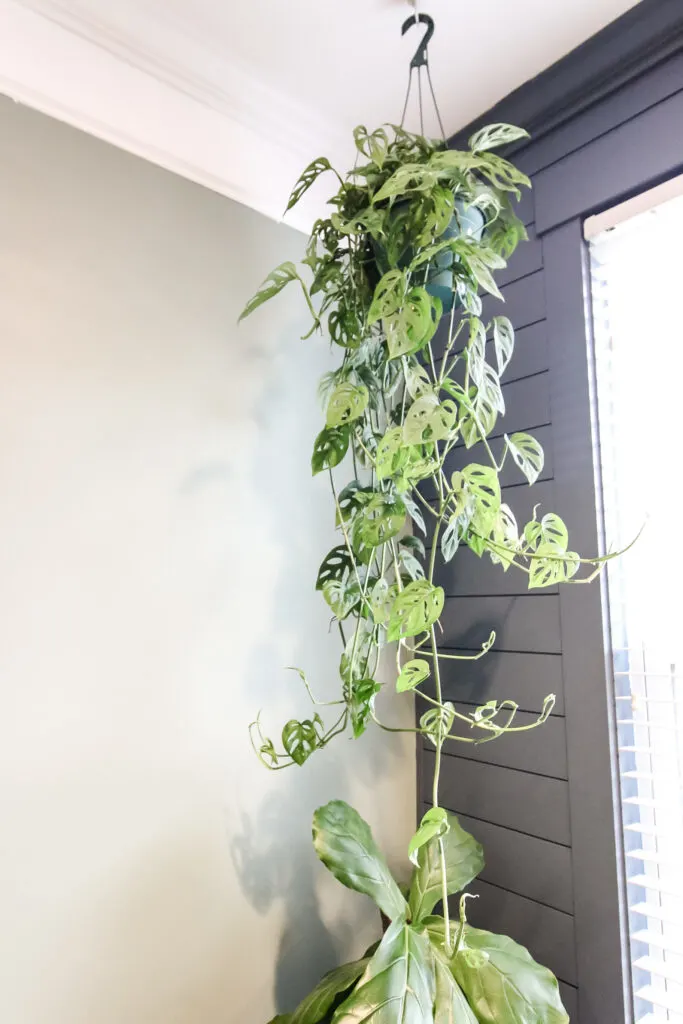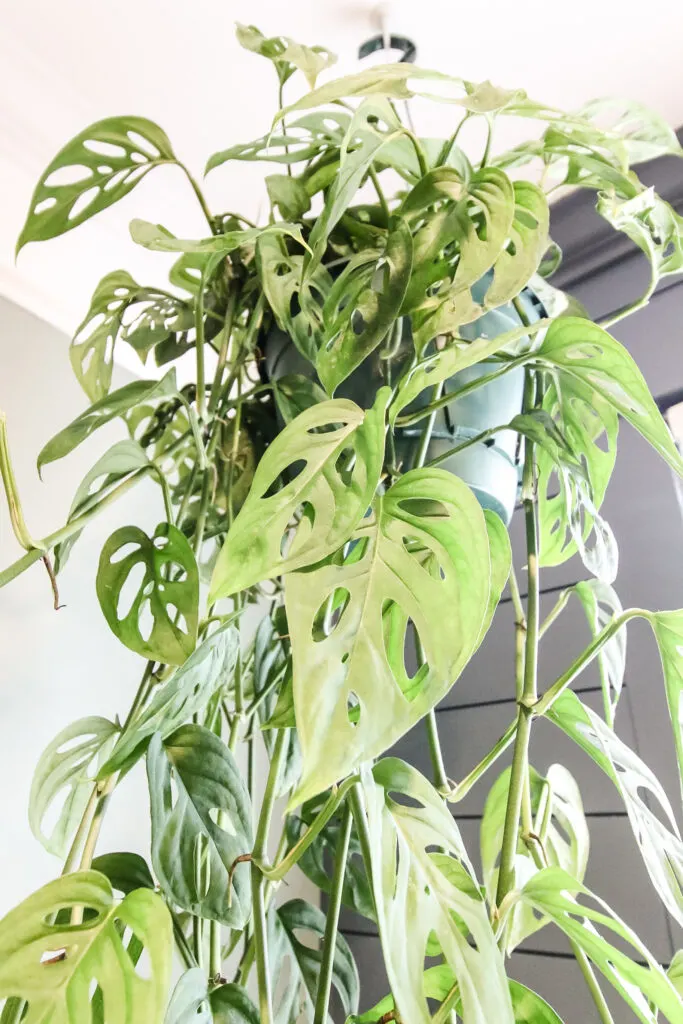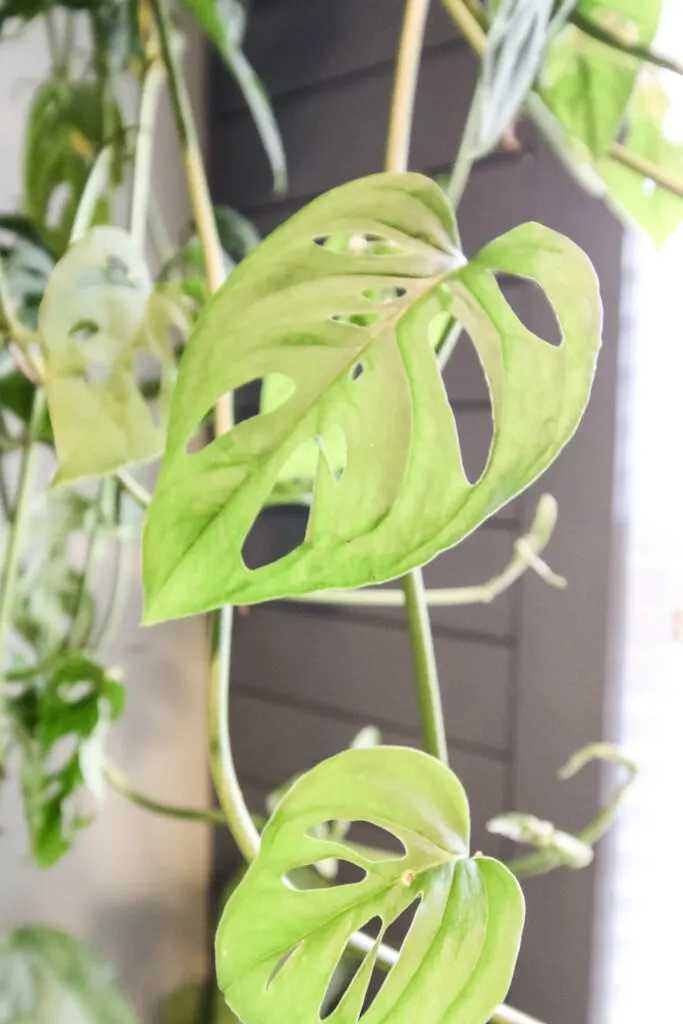Considering buying a swiss cheese plant? I don’t blame you, they are gorgeous! Here’s everything you need to know about swiss cheese plant care!
I recently discovered the swiss cheese vine plant when I was shopping at – you guessed it – Plant House.
I was immediately drawn to the plant for a few reasons. One, it looks like a pothos, which is in my opinion one of the easiest plants to not only keep alive but keep thriving.
But, the leaves have intricate holes in them. Yes – this is a plant with holes like a piece of swiss cheese. It’s super unique looking and they grow really fast and are easy to keep alive!
I love my swiss cheese vine, so let’s talk about this popular houseplant today!

What is the swiss cheese plant?
Swiss cheese plant is the common name for monstera adansonii. It is a vining plant with heart shaped green leaves that have holes in them that look like swiss cheese holes!
What are the types of swiss cheese plant?
- Monstera adansonii
- Monstera deliciosa
- Monstera borsigiana
- Monstera obliqua
How does swiss cheese plant get holes
The evolution behind the swiss cheese plant vine leaf holes is actually very interesting.
Plants absorb light through their leaves. The swiss cheese plant naturally grows under large rainforest trees, and catches sun through the gaps in the branches.
Developing holes in the leaves allows the plant to make larger leaves – more likely to find the sun – without having to use the energy to fill them in all the way. Same square footage but much more coverage than smaller solid leaves!

Is Monstera adansonii rare?
No, these plants might have been rare at some point, but they are no longer considered rare. They are regularly available in standard house plant stores and greenhouses!
Is swiss cheese plant a philodendron?
hile their leaves are heart shaped like a philodendron, swiss cheese plant is not a philodendron!
Is swiss cheese plant easy to grow?
Yes, swiss cheese plant are easy to grow and keep happy. You just need to be sure it gets enough light and proper watering!
Is the swiss cheese plant toxic?
Yes – the swiss cheese plant is toxic to pets and humans if eaten and can cause burning to the mouth and throat, indigestion, and even death.
Is the swiss cheese plant safe for cats?
No, the swiss cheese plant is not safe for pets – it is toxic if eaten. Keep them in a place pets cannot reach. They are beautiful in hanging baskets!

Is the swiss cheese plant an air purifier?
Yes, swiss cheese plants are said to be great at purifying the air inside your home!
Can swiss cheese plant live outside?
If the conditions are right, swiss cheese plant can live outdoors. Just remember that they do not do well in direct sunlight – they will get burnt!
Can Monstera adansonii take full sun?
No – the leaves of this plant will get brown and crispy sunburn spots from too much sun. They prefer bright, indirect or filtered light!
Why is my swiss cheese plant dying?
Uh oh! Whether you have yellowing, drooping, or brown crispy leaves, you want to fix your plant ASAP to keep it alive. Here’s my guide on why your swiss cheese plant is dying!
Should my swiss cheese vine be hanging or climbing?
Swiss cheese vines can hang out of a pot or hanging basket or climb! It loves to climb and will really flourish is a climbing environment!
Can you grow swiss cheese plant on a moss pole?
Yes, Swiss cheese plant loves a moss pole! You will want to tie it up initially and as it sprouts new growth to encourage it to grow in the right direction! It will eventually sprout aerial roots to hold itself in place.
Plants usually grow larger leaves when they have something to climb.
Can swiss cheese plant grow in low light
Swiss Cheese plant can survive in low light – but it won’t thrive. Interestingly enough, Swiss cheese plant leaves won’t develop their signature holes in low light situations! If you see yellowing leaves, it really needs more light!
How fast does the Swiss cheese plant grow?
The swiss cheese vine is a very fast growing plant! It grows long, vining arms very quickly when given enough light and the right amount of water.

San swiss cheese plant grow in water?
Swiss cheese plants are often propagated in water. But, can they stay there forever? The short answer is that yes, swiss cheese plant can grow in water.
However, it has been found that swiss cheese plants that are left to grow in water don’t grow as large or lush compared to those with the stability of soil for their roots. Just something to keep in mind!
Does swiss cheese plant need support?
Swiss cheese plant is happy to grow hanging from a planter. However, if you want it to grow upward or outward, you will need to support the vining branches to encourage them to grow in your preferred direction!
Does swiss cheese plant need drainage?
YES! Swiss cheese plants need well draining soil or they will get soggy and can get root rot – which is deadly.
My favorite hack for this is to leave the plant in the plastic nursery pot from the store that should have large drainage holes. Simply set that pot within your more beautiful decorative pot. Assuming there’s space in there, it gives water space to drain out into.
How to repot a swiss cheese plant
Even if your swiss cheese plant isn’t root bound, it’s good to repot it every year just to give it fresh soil. To do so:
- Gently shake the plant + root ball out from their pot.
- Use gloved hands to carefully massage or shake the root ball to loosen and remove loose dirt.
- Add fresh, well draining soil to your pot (the same pot or one 2 inches larger if needed)
- Replace the root ball of the plant in the pot
- Top with soil to cover the roots and fill the pot
- Water and place in indirect sunlight
How to prune swiss cheese plant
Pruning a swiss cheese plant is very easy. You can cut off yellowed or brown leaves at any time.
If your plant is getting too long, simply use clean scissors to cut just before a leaf node – the bump leaves grow out of. Leaving the node on the cutting will allow it to easily root!
Swiss cheese plant care
What kind of light does the swiss cheese plant need
The swiss cheese plant needs bright, indirect light. Direct sun will burn its leaves.
What kind of watering does a swiss cheese plant need
I water my swiss cheese plant once a week. I water deeply, until water flows out the drainage holes.
You can also bottom-water your swiss cheese plant. To do that, set it in cup or bowl of water and let it absorb the water through it’s drainage holes!
What kind of pot and soil does a swiss cheese plant need
Swiss cheese plant does well with standard potting soil, provided that it is paired with a pot with good drainage.
I keep my plant in a plastic nursery pot from the store and set it in the sink to water, allowing the water to drain into the sink for about an hour before hanging it back up!
What temperature does the swiss cheese plant need?
Swiss cheese plant prefers temperatures between 60F and 85F degrees and high humidity. They are likely to die at anything under 30 degrees. They can survive between 30 and 60 degrees for short periods of time, but will go dormant and stop growing.
How to propagate a swiss cheese plant
Swiss cheese plant is very easy to propagate in water! To root this plant:
- Select a healthy branch to take your cutting from off the mother plant – one with healthy new growth is best.
- Cut just below a node – the bump a leaf grows from. I like to cut so theres 2-3 nodes on my cutting. You want to cut the last node off so the bottom of your cut off piece is a node.
- Remove the bottom leaf.
- Place the cutting in water. You want ideally 2 nodes under water and they will both sprout roots!
- Set in indirect sun and wait for leaves to form.
- Once the roots are 2-3 inches long, you can plant it in soil in a well drained pot!
Thanks for reading!


Hey there, I’m Morgan, a houseplant enthusiast from sunny Charleston, South Carolina. Growing up surrounded by my mom’s lush orchids and African violets, I discovered the magic of bringing nature indoors. Thanks to the pandemic, I delved deeper into houseplants, discovering their power to uplift moods and transform spaces. I’m here to spill all my secrets, helping you pick the perfect houseplant – and make it happy. Let’s keep your plants alive, together! 😊
